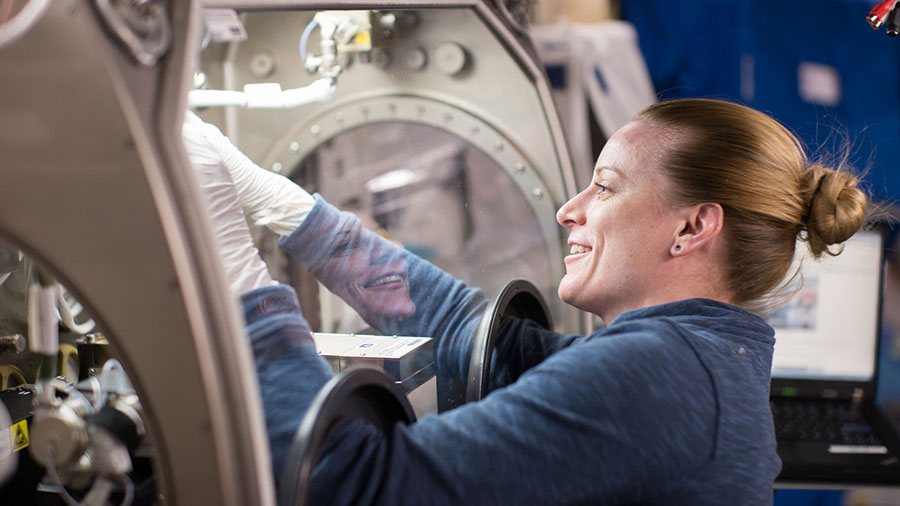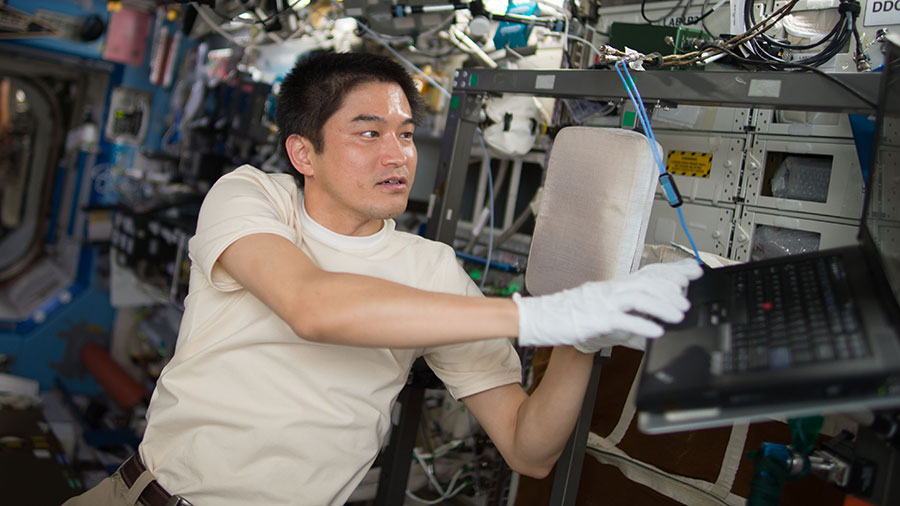SPACE STATION (NASA)
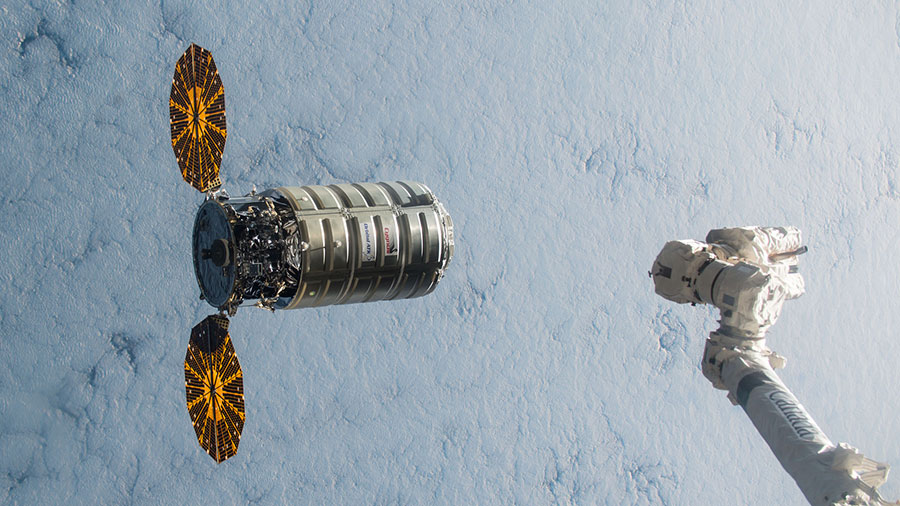
The Cygnus spacecraft is pictured Dec. 9, 2015, moments before it was captured by the Canadarm2 robotic arm.
The Cygnus spacecraft is targeted to launch atop an Antares rocket Oct. 13 from the Mid-Atlantic Regional Spaceport in Virginia. NASA and Orbital ATK officials successfully completed a flight readiness review and are working towards an Oct. 11 roll out of the vehicle to the launch pad.
This will be the sixth cargo mission to the International Space Station for Orbital ATK which will be packing about 2,400 kilograms of crew supplies and research gear inside Cygnus. While mission managers work on pre-launch activities, the Expedition 49 crew is preparing for Cygnus’ cargo delivery and training for its robotic capture.
Astronauts Kate Rubins and Takuya Onishi will monitor Cygnus from the robotics workstation inside the cupola during its approach and rendezvous. When Cygnus reaches a point about 10 meters from the station the duo will command the 57.7-foot Canadarm2 to grapple the resupply ship. Ground controllers will then remotely take control of Canadarm2 and mount Cygnus to the Unity module.
Despite a busy schedule, all three crew members, including Commander Anatoly Ivanishin, continue pressing ahead with ongoing science experiments and station maintenance. Onishi is in the middle of a study documenting his nutritional intake this week while Rubins checked out a U.S. spacesuit today. Ivanishin worked on Russian life support systems and had time set aside for space research.
Get weekly video highlights at: http://jscfeatures.jsc.nasa.gov/videoupdate/
Cygnus Training Under Way Before Launch Set
Leave a reply
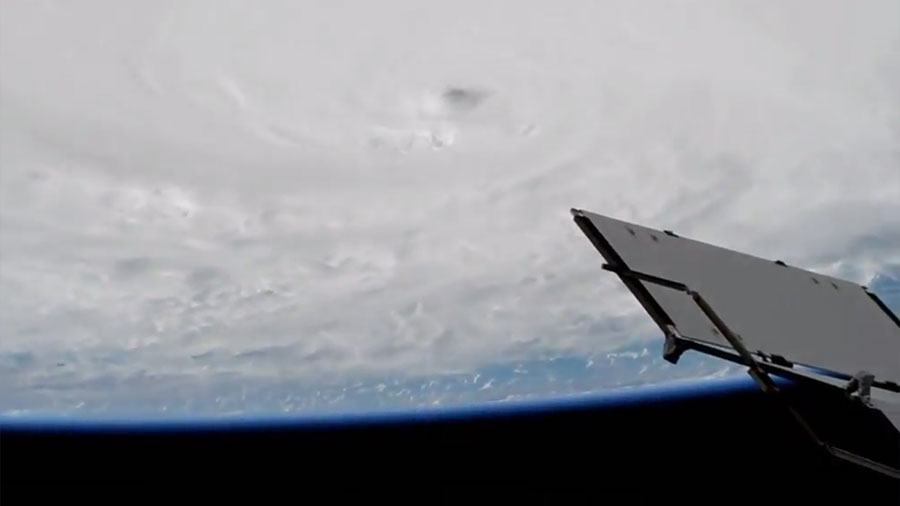
Hurricane Matthew (eye at top center) was pictured from the space station on the afternoon of Oct. 3, 2016. Credit:@Space_Station
The Expedition 49 crew is getting ready for the mid-October arrival of the Orbital ATK Cygnus spacecraft. The trio is also exploring human research and setting up a student Earth observation experiment.
First-time astronauts Kate Rubins and Takuya Onishi are brushing up on the robotic capture techniques necessary to grapple the Cygnus cargo craft. The Cygnus private space freighter is targeted to launch from Virginia between Oct. 9 and 13 and arrive at the International Space Station about 2-1/2 days later.
The duo will be inside the cupola at the robotics controls monitoring Cygnus’ arrival then capturing it with the 57.7 foot long Canadarm2. Ground controllers will then take over robotic operations and remotely attach Cygnus to the Unity module. Cygnus is delivering crew supplies, scientific research and hardware to the station crew members.
Before the pair began training today, Rubins sampled the station’s water for microbes and stowed the Hard to Wet Surfaces research gear. Onishi tested his fine motor skills on a mobile tablet device and logged his diet for the ENERGY experiment.
Commander Anatoly Ivanishin set up the Sally Ride EarthKAM experiment inside a Harmony module window today. The Earth imagery gear allows students to take pictures of Earth from space and share them on the internet.
Get weekly video highlights at: http://jscfeatures.jsc.nasa.gov/videoupdate/
Expedition 49 Trio Wrapping Up Busy September
September was a busy month on the International Space Station filled with a wide variety of space research, a spacewalk, a crew departure and a test of the new BEAM module. One science highlight this month includes a new experiment that may improve how medicine works.
This week, astronaut Kate Rubins tested the endurance of the new Bigelow Expandable Aerospace Module in the vacuum of space. She also explored how solids dissolve in liquids to help the medicine industry design better performing drugs for humans on Earth and astronauts in space.
A new fuel burning study is about to start soon after Japanese astronaut Takuya Onishi completes the installation of the Group Combustion experiment. Results from the fire research could help engineers design advanced rocket engines and industrial furnaces. Onishi is also documenting his meals over the next few days for the ENERGY study. Onishi’s meal data in conjunction with his water and breath samples will help scientists understand the nutritional requirements necessary for long-term space missions.
Cosmonaut Anatoly Ivanishin, who took command of Expedition 49 on Sept. 6, has been working on the continuous upkeep of the Russian segment of the space station. The veteran cosmonaut has been preparing a Progress resupply ship for its Oct. 14 undocking. Some of the numerous Russian science experiments Ivanishin has been conducting have been observing the condition of the Earth and exploring human research.
Get weekly video highlights at: http://jscfeatures.jsc.nasa.gov/videoupdate/
BEAM Open Today for Tests
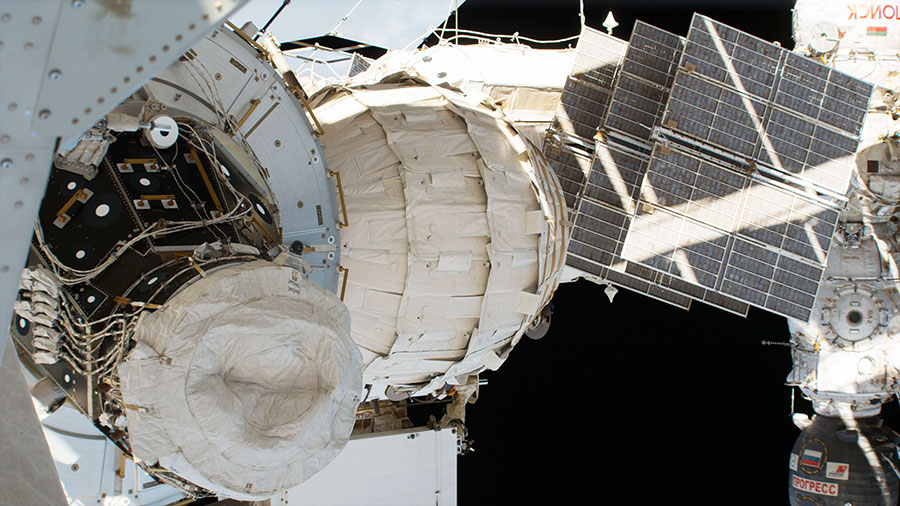
BEAM, the Bigelow Expandable Activity Module, is pictured installed on the Tranquility module and expanded to its full-size volume.
BEAM, the new expandable module attached to the International Space Station, was opened up today for tests and equipment checks. The Expedition 49 crew also explored eating right in space, adapting to new technology and studied a variety of other life science and physics research.
Flight Engineer Kate Rubins opened up and entered the Bigelow Expandable Activity Modulethis afternoon. She temporarily installed gear inside BEAM for a test to measure the loads and vibrations the module experiences. Rubins started her day with a performance test on a mobile tablet device then videotaped her observations of the living conditions aboard the space station.
Japanese astronaut Takuya Onishi started an 11-day run today to document his meals while wearing a monitor that will take water samples and measure his breathing. The ENERGYexperiment will help doctor’s understand metabolism in space and ensure astronauts are properly nourished to maintain the energy required for a long-term mission. Onishi is also continuing to set up the Group Combustion fuel burning study and checked for pressure leaks in the experiment gear.
In the Russian side of the orbital laboratory, Commander Anatoly Ivanishin resumed studyingcharged particle systems trapped in a magnetic field. He also participated in a pair of Earth photography experiments observing how natural and man-made disasters including industrial activities affect the land and sea.
Get weekly video highlights at: http://jscfeatures.jsc.nasa.gov/videoupdate/
Sound Check as Physics and Life Research Continues
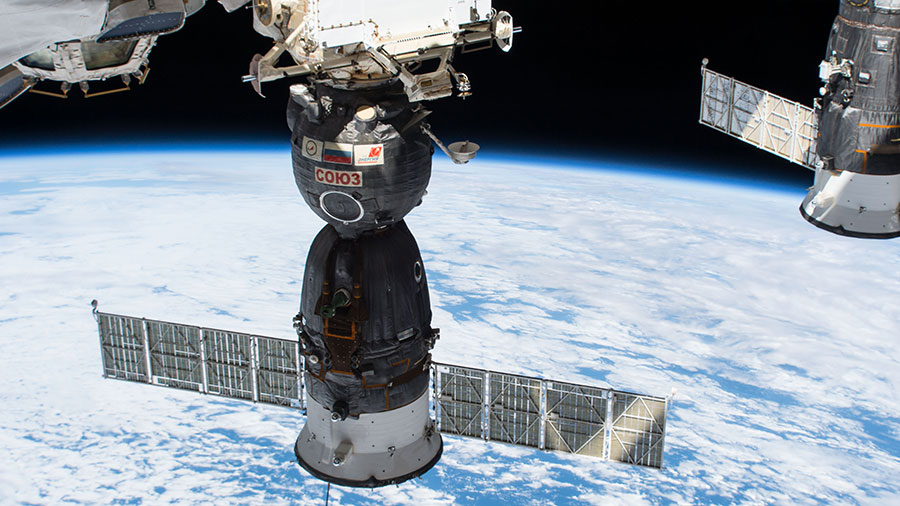
The Soyuz MS-01 spacecraft is pictured during a day time pass over the Earth.
The three Expedition 49 crew members measured noise levels on the International Space Station today and continued exploring how physical and organic phenomena are affected by weightlessness.
NASA astronaut Kate Rubins surveyed the acoustic environment inside the station today. She analyzed the sound levels of various life support gear and took standard measurements in the Destiny lab module and the Zvezda service module. Rubins also partnered up with Japanese astronaut Takuya Onishi to remix, photograph and stow samples for the Hard to Wet Surfacespharmaceutical study.
Onishi began his day testing his performance on a mobile tablet device. The study, known asFine Motor Skills, observes how an astronaut adapts to new technology and could help engineers design next generation spacecraft, spacesuits and tools. He then moved onto setting up equipment for the upcoming Group Combustion experiment to research how fuel burns in space. Results could influence the future production of rocket engines and industrial furnaces.
On the Russian side of the station, Commander Anatoly Ivanishin sampled different areas searching for mold fungus and bacteria contamination. The commander then repressurized the station’s environment with air from a docked cargo ship and worked on life support system maintenance.
Get weekly video highlights at: http://jscfeatures.jsc.nasa.gov/videoupdate/
Fire and Water Studies for Space and Earth Benefits
Two different studies are under way on the International Space Station – one will observe how fuel burns in space while another is researching how medicine dissolves in water. Results from both experiments could benefit humans on Earth and in space.
Astronaut Takuya Onishi is setting up the Group Combustion experiment that will explore how flames spread across a cloud of fuel droplets. Observations may help engineers design advanced rocket engines, as well as gas turbines and industrial furnaces.
NASA astronaut Kate Rubins is researching how pharmaceutical materials dissolve in water for the Hard to Wet Surfaces study. The space environment can reveal processes masked by Earth’s gravity and help scientists improve how drugs work in humans on Earth and in space.
Commander Anatoly Ivanishin was back at work studying how charged particle systems react when trapped in a magnetic field. The veteran cosmonaut, who is on his second station mission, also explored new methods to detect and target landmarks improving Earth photography techniques.
Get weekly video highlights at: http://jscfeatures.jsc.nasa.gov/videoupdate/
NASA and Orbital ATK Prepping for Mid-October Cargo Mission

The Cygnus spacecraft is pictured before its capture Dec. 9, 2015 at the International Space Station.
Mission managers are targeting the Oct. 9-13 timeframe for the launch of the sixth Orbital ATK resupply mission to the International Space Station. A pair of astronauts onboard the station are also training for the robotic capture of the Cygnus resupply ship from Orbital ATK when it arrives about two days after launch.
Cygnus’ primary mission is to deliver about 2,400 kilograms of supplies and science experiments to the Expedition 49 crew. When Cygnus departs the station about a month later it will participate in secondary missions including combustion research and deploying CubeSats for weather forecasting before reentering Earth’s atmosphere.
Astronauts Kate Rubins and Takuya Onishi called down to ground controllers today to review and train for next month’s planned arrival of the Cygnus. The duo will be in the cupola monitoring the Cygnus’ rendezvous and approach before grappling and installing the spacecraft with Canada’s robotic arm Canadarm2.
The duo also collected saliva samples for stowage in a science freezer and participated in body mass measurements. Commander Anatoly Ivanishin explored new ways to detect pressure leaks on the space station and continued more research into charged particle systems in magnetic fields.
Get weekly video highlights at: http://jscfeatures.jsc.nasa.gov/videoupdate/
Eye Scans, Orbital Plumbing and Story Time for Crew
Astronauts Kate Rubins and Takuya Onishi are continuing more eye checks today in the middle of day-long orbital plumbing work. Commander Anatoly Ivanishin packed trash in a resupply ship and researched a variety of Earth and space phenomena.
Rubins and Onishi scanned each other’s eyes today using an ultrasound. Doctors on the ground assisted the duo and will use the data to determine how living in space affects vision and the shape of the eye. The pair also participated in the Story Time From Space video series for children demonstrating simple physics experiments.
Onishi spent most of his day replacing parts such as sensors and valves in the bathroom, or the Water and Hygiene Compartment, located in the Tranquility module. Rubins analyzed the quality of the station’s water supply and sampled for microbes, silica and organic material.
Ivanishin, a veteran cosmonaut on his second station mission, is getting the Progress 63 cargo craft ready for departure next month. He transferred cargo and trash to and from the resupply ship then updated the station’s inventory management system. The commander also spent some time exploring new ways to monitor natural disasters, how the digestive system adapts in space and detecting orbital debris and micrometeoroid impacts on the station.
Get weekly video highlights at: http://jscfeatures.jsc.nasa.gov/videoupdate/
U.S. and Russia Targeting Mid-October Cargo Missions
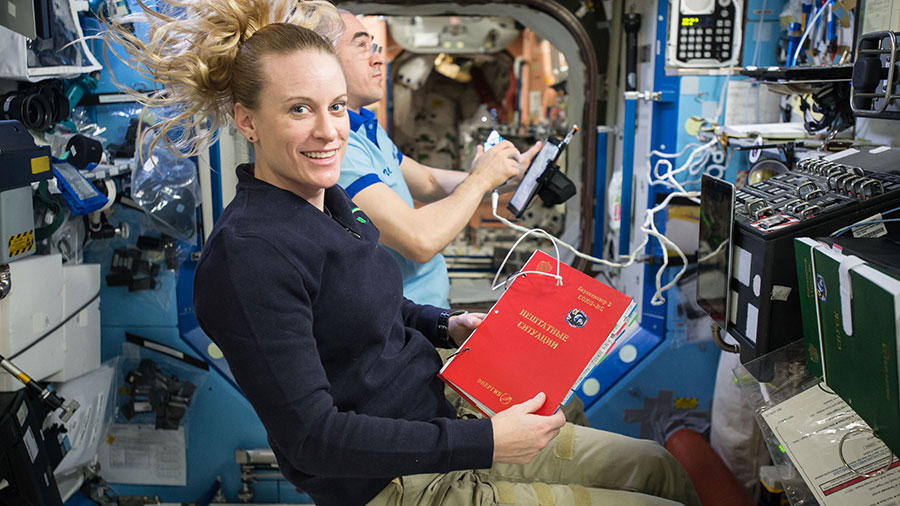
NASA astronaut Kate Rubins holds a reference guide during an emergency descent drill aboard the space station.
The United States and Russia are working to get a pair of cargo ships ready for a mid-October launch schedule to the International Space Station. While the new shipments are being processed, the Expedition 49 crew conducted eye checks, wore carbon dioxide monitors and prepared for a fuel combustion experiment.
The U.S. company Orbital ATK is targeting the Oct. 9-13 time frame for the launch of its sixth Commercial Resupply Services mission to the space station. Its Cygnus spacecraft will be scheduled to launch atop an Antares rocket from Wallops Island, Va., after successfully completing operational milestones and technical reviews.
The next resupply mission will be Oct. 20 when the Progress 65 cargo craft launches from Kazakhstan on a two-day trip to the space station. The new Russian space freighter will replace the Progress 63 after it undocks Oct. 14 from the rear port of the Zvezda service module.
Back on orbit, astronauts Kate Rubins and Takuya Onishi paired up for routine eye exams today with remote support from ground personnel. Rubins, from NASA, also wore personal devices to demonstrate the ability to monitor a crew member’s exposure to carbon dioxide aboard a spacecraft.
Onishi, from the Japan Aerospace Exploration Agency, continued setting up gear to begin theGroup Combustion experiment next week. That study will explore how flames fed by fuel droplets spread in microgravity.
Get weekly video highlights at: http://jscfeatures.jsc.nasa.gov/videoupdate/
Astronauts Study Pill Properties and Laser Heating
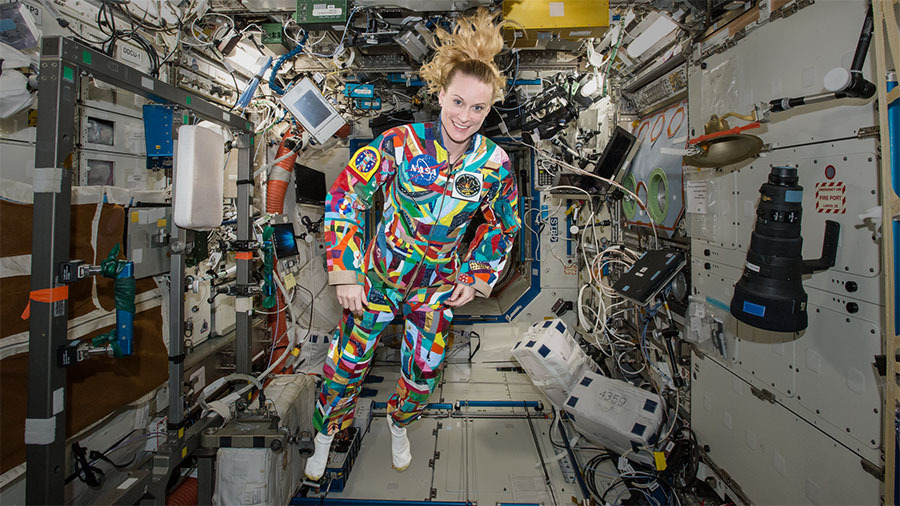
Astronaut Kate Rubins wears a hand-painted spacesuit decorated by patients recovering at the MD Anderson Cancer Center to raise awareness about the benefits of pairing art with medicine.
The Expedition 49 crew is helping the pharmaceutical industry improve drug design while also helping researchers understand the properties of materials burning at high temperatures. The International Space Station‘s microgravity environment helps reveal new characteristics of physical and organic processes cloaked by Earth’s gravity. Scientists, doctors and engineers use these observations to design products and procedures to benefit humans living on Earth and in space.
The new Eli Lilly-Hard to Wet Surfaces experiment is researching how different materials dissolve in water. NASA astronaut Kate Rubins set up a camera to automatically photograph the process today using six samples. Results could benefit how pills are designed improving drug delivery inside the body.
Japanese astronaut Takuya Onishi swapped samples for the Group Combustion experiment inside the Electrostatic Levitation Furnace. The furnace is a device that observes and measures the thermophysical properties of materials heated to high temperatures using lasers. Onishi is also closing out the Mouse Epigenetics study and cleaning up the Cell Biology Experiment Facility. The life science facility contains an incubator with an artificial gravity generator.
Commander Anatoly Ivanishin continued checking out Russian laptop computers and life support systems today. The veteran cosmonaut also transferred gear from a cargo ship and wrapped up a 24-hour data recording session for the Cosmocard blood circulation study.
Get weekly video highlights at: http://jscfeatures.jsc.nasa.gov/videoupdate/
International Space Station

The International Space Station Geocache is literally "out of this world." It orbits the earth at 17000 MPH at an altitude of 250 miles.
This listing was published with permission from Groundspeak.
I traveled to the ISS on October 12, 2008 becoming the first second generation astronaut. While there I created this geocache aboard the Russian Segment of the ISS. The cache itself is locker #218 as shown in the provided photograph. There is no logbook in this cache, out of respect for the Russian segment of the ISS, and the fact that it would be a fire hazard to include one in this locker. You will find, however, that I attached a Travel Bug to the locker. I am hopeful that any future geocaching astronauts will start my Travel Bug on its way home, and leave one of their own in its place to start a similar journey.
The International Space Station orbits about 250 miles above the earth and travels about 17000 miles per hour, completing an orbit of the earth every 90 minutes.
Today only the American Space Shuttle and Russian Soyuz vehicles can reach the ISS. This will be changing soon, not only is the shuttle retiring soon, but there is a fleet of private space vehicles coming soon, which will allow greater access to space and hopefully ultimately the space station. Thus, while today only about 500 people have made this journey, and I am sure I am not the only geocacher among them... many more will be reaching space soon, and I am hopeful to see many visitors in time.

